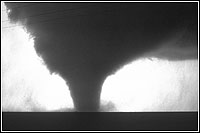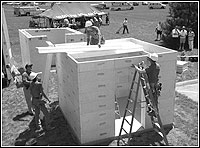|
|
Tornadoes
 Tornadoes are nature’s most violent storms. Spawned from powerful thunderstorms, tornadoes can uproot trees, destroy buildings and turn harmless objects into deadly missiles. They can devastate a neighborhood in seconds. Tornadoes are nature’s most violent storms. Spawned from powerful thunderstorms, tornadoes can uproot trees, destroy buildings and turn harmless objects into deadly missiles. They can devastate a neighborhood in seconds.
A tornado appears as a rotating, funnelshaped cloud that extends to the ground with whirling winds that can reach 300 miles per hour. Damage paths can be in excess of one mile wide and 50 miles long. Every state is at some risk from this hazard.
Tornado facts
- A tornado is a violently rotating column of air extending from a thunderstorm to the ground.
- Tornadoes are capable of destroying homes and vehicles and can cause fatalities.
- Tornadoes may strike quickly, with little or no warning.
- Tornadoes may appear nearly transparent until dust and debris are picked up or a cloud forms in the funnel. The average tornado moves SW to NE but tornadoes have been known to move in any direction.
- The average forward speed is 30 mph but may vary from stationary to 70 mph with rotating winds that can reach 300 miles per hour.
- Tornadoes can accompany tropical storms and hurricanes as they move onto land.
- Waterspouts are tornadoes that form over water.
- Tornadoes are most frequently reported east of the Rocky Mountains during spring and summer months but can occur in any state at any time of year.
- In the southern states, peak tornado season is March through May, while peak months in the northern states are during the late spring and early summer.
- Tornadoes are most likely to occur between 3 p.m. and 9 p.m., but can occur at any time of the day or night.
What to do before tornadoes threaten
- Know the terms used to describe tornado threats:
- Tornado Watch - Tornadoes are possible. Remain alert for approaching storms. Watch the sky and stay tuned to radio or television to know when warnings are issued.
- Tornado Warning - A tornado has been sighted or indicated by weather radar. Take shelter immediately.
- Ask your local emergency management office or American Red Cross chapter about the tornado threat in your area. Ask about community warning signals.
- Purchase a NOAA Weather Radio with a battery backup and tone-alert feature that automatically alerts you when a Watch or Warning is issued (tone alert not available in some areas). Purchase a battery-powered commercial radio and extra batteries as well.
- Know the county or parish in which you live. Counties and parishes are used in Watches and Warnings to identify the location of tornadoes.
- Determine places to seek shelter, such as a basement or storm cellar. If an underground shelter is not available, identify an interior room or hallway on the lowest floor.
- Practice going to your shelter with your household.
- Know the locations of designated shelters in places where you and your household spend time, such as public buildings, nursing homes and shopping centers. Ask local officials whether a registered engineer or architect has inspected your children’s schools for shelter space.
- Ask your local emergency manager or American Red Cross chapter if there are any public safe rooms or shelters nearby. See the “Safe Room and Shelter” section at the end of this chapter for more information.
- Assemble a disaster supplies kit. Keep a stock of food and extra drinking water. See the “Emergency Planning and Disaster Supplies” and “Evacuation” chapters for more information.
- Make a record of your personal property. Take photographs or videotapes of the exterior and interior of your home, including personal belongings. Store these documents in a safe place, such as a safe deposit box.
What to do during a tornado watch
- Listen to NOAA Weather Radio or to commercial radio or television newscasts for the latest information.
- Be alert for approaching storms. If you see any revolving funnel shaped clouds, report them immediately by telephone to your local police department or sheriff’s office.
- Watch for tornado danger signs:
- Dark, often greenish sky
- Large hail
- A large, dark, low-lying cloud (particularly if rotating)
- Loud roar, similar to a freight train
- Caution:
- Some tornadoes are clearly visible, while rain or nearby low-hanging clouds obscure others.
- Occasionally, tornadoes develop so rapidly that little, if any, advance warning is possible.
- Before a tornado hits, the wind may die down and the air may become very still.
- A cloud of debris can mark the location of a tornado even if a funnel is not visible.
- Tornadoes generally occur near the trailing edge of a thunderstorm. It is not uncommon to see clear, sunlit skies behind a tornado.
- Avoid places with wide-span roofs such as auditoriums, cafeterias, large hallways, supermarkets or shopping malls.
- Be prepared to take shelter immediately. Gather household members and pets. Assemble supplies to take to the shelter such as flashlight, batterypowered radio, water, and first aid kit.
| With your household, determine where you would take shelter in case a Tornado Warning was issued. Storm cellars or basements provide the best protection. If underground shelter is not available seek shelter in an interior room or hallway on the lowest floor. |
What to do during a tornado warning
When a tornado has been sighted, go to your shelter immediately.
- In a residence or small building, move to a predesignated shelter, such as a basement, storm cellar or “Safe Room or Shelter.”
- If there is no basement, go to an interior room on the lower level (closets, interior hallways). Put as many walls as possible between you and the outside. Get under a sturdy table and use arms to protect head and neck. Stay there until the danger has passed.
- Do not open windows. Use the time to seek shelter.
- Stay away from windows, doors and outside walls. Go to the center of the room. Stay away from corners because they attract debris.
- In a school, nursing home, hospital, factory or shopping center, go to predetermined shelter areas. Interior hallways on the lowest floor are usually safest. Stay away from windows and open spaces.
- In a high-rise building, go to a small, interior room or hallway on the lowest floor possible.
- Get out of vehicles, trailers and mobile homes immediately and go to the lowest floor of a sturdy nearby building or a storm shelter. Mobile homes, even if tied down, offer little protection from tornadoes.
- If caught outside with no shelter, lie flat in a nearby ditch or depression and cover your head with your hands. Be aware of potential for flooding.
- Do not get under an overpass or bridge. You are safer in a low, flat location.
- Never try to outrun a tornado in urban or congested areas in a car or truck; instead, leave the vehicle immediately for safe shelter. Tornadoes are erratic and move swiftly.
- Watch out for flying debris. Flying debris from tornadoes causes most fatalities and injuries.
| If caught outside with no shelter when a tornado hits, lie flat in a nearby ditch or depression and cover your head with your hands. Be aware of potential for flooding. |
What to do after a tornado
- Look out for broken glass and downed power lines.
- Check for injuries. Do not attempt to move seriously injured persons unless they are in immediate danger of death or further injury. If you must move an unconscious person, first stabilize the neck and back, then call for help immediately.
- If the victim is not breathing, carefully position the victim for artificial respiration, clear the airway and commence mouth-tomouth resuscitation.
- Maintain body temperature with blankets. Be sure the victim does not become overheated.
- Never try to feed liquids to an unconscious person.
- Use caution when entering a damaged building. Be sure that walls, ceiling and roof are in place and that the structure rests firmly on the foundation. Wear sturdy work boots and gloves.
- See the “Recovering From Disaster” chapter for more important information.
 Wind “Safe Room and Shelter” Wind “Safe Room and Shelter”
Extreme windstorms in many parts of the country pose a serious threat to buildings and their occupants.
Your residence may be built “to code,” but that does not mean that it can withstand winds from extreme events like tornadoes or major hurricanes.
The purpose of a wind shelter or “Safe Room” is to provide a space where you and your household can seek refuge that provides a high level of protection. You can build a shelter in one of the several places in your home:
- In your basement
- Beneath a concrete slab-on-grade foundation or garage floor
- In an interior room on the first floor Shelters built below ground level provide the greatest protection, but a shelter built in a first-floor interior room can also provide the necessary protection. Belowground shelters must be designed to avoid accumulating water during the heavy rains that often accompany severe windstorms.
To protect its occupants, an in-house shelter must be built to withstand high winds and flying debris, even if the rest of the residence is severely damaged or destroyed. Therefore:
- The shelter must be adequately anchored to resist overturning and uplift.
- The walls, ceiling, and door of the shelter must withstand wind pressure and resist penetration by windborne objects and falling debris.
- The connections between all parts of the shelter must be strong enough to resist the wind.
- If sections of either interior or exterior residence walls are used as walls of the shelter, they must be separated from the structure of the residence, so that damage to the residence will not cause damage to the shelter.
If you are concerned about wind hazards where you live, especially if you live in high-risk areas, you should consider building a shelter. Publications are available from FEMA to assist in determining if you need a shelter and how to construct a shelter. Contact the FEMA distribution center for a copy of Taking Shelter from the Storm (L-233 for the brochure and FEMA-320 for the booklet with complete construction plans).
|
 |